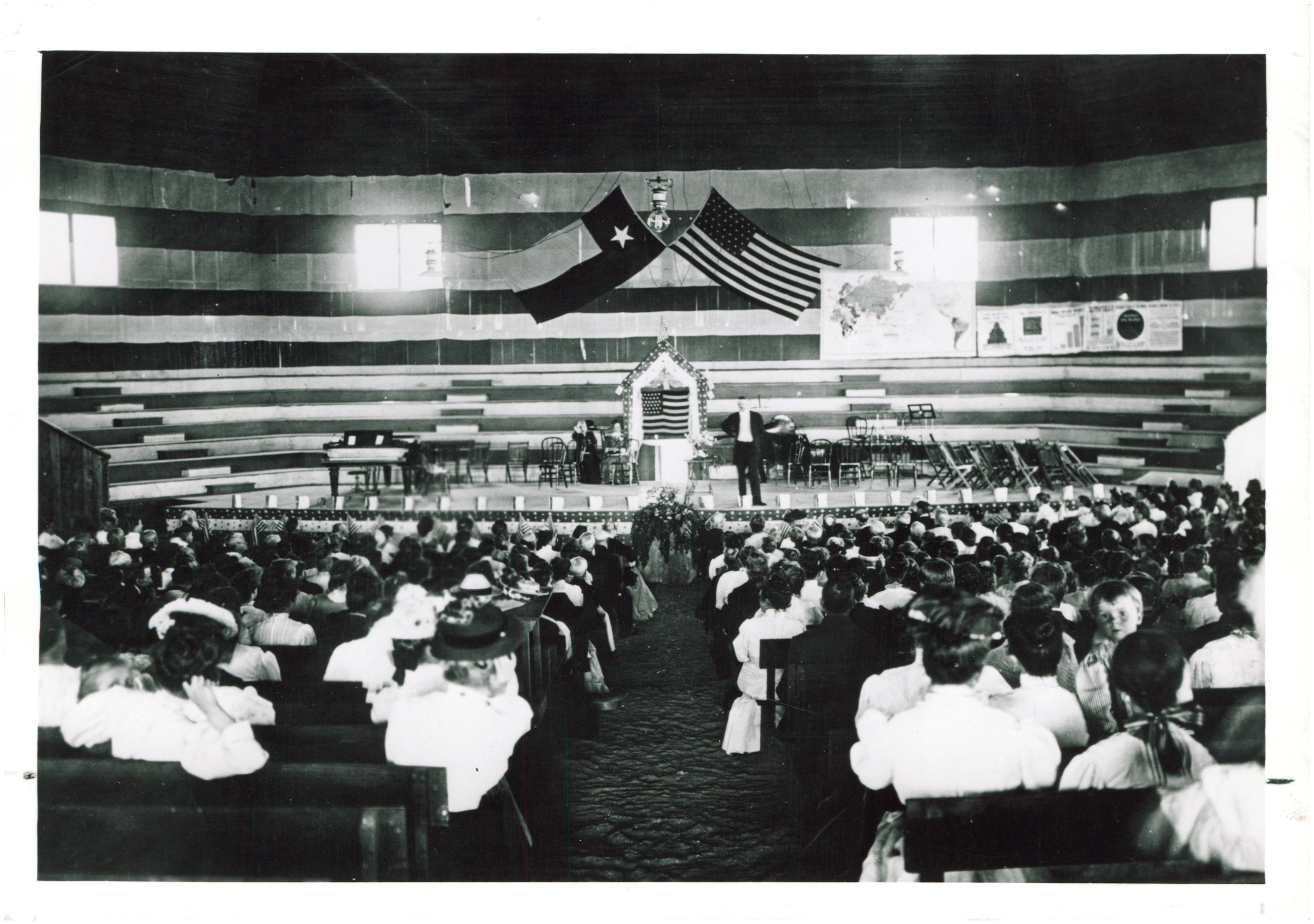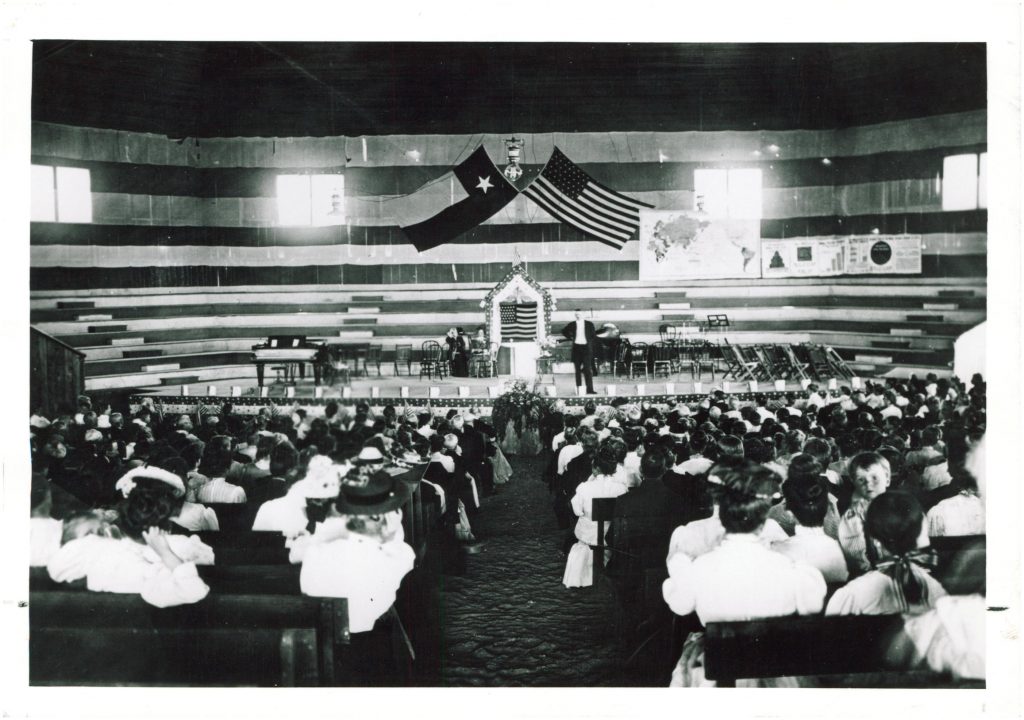The Auditorium
When the Auditorium was built in 1898 it was not as comfortable as it is today.
The floor was dirt covered with sawdust. ”The children may play in the sand at their parents’ feet,” said the Chautauqua Bulletin. The auditorium was originally open on three sides to provide for free passage of air. But with the slightest breeze, or even when anyone walked about, dense clouds of sawdust and dirt filled the building, obscuring the view of the stage and often requiring a wet handkerchief held over the mouth. Sprinkling water on the floor, installing huge wooden doors on the north and south sides of the building, and even boarding up the west windows didn’t help much. Mary Bradford Rovetta, a summer resident from 1915 through 2015, remembers that in the 1920s, the children would sneak into the Auditorium every morning to search in the sawdust for change that had fallen out of the men’s pockets the night before. A ring lost in 1912 was found in the sawdust in 1915.
In 1917 Chautauqua contracted to have the center section of the floor covered with concrete. After that, sections were paved in at least six separate yearly projects. Holes under the seats were filled and the entrances paved in 1948. Concreting was finally completed in 1950.
The Auditorium could seat 6000 people on wooden benches. They were hard. “Cushion boys” rented cushions at five cents each. In 1917, 600 “opera chairs” replaced the benches in the center sections, followed in 1941 by 150 salvaged from Whittier School, in 1950 by 350 from the Loveland Theater, and In 1965 by 600 from CU. In the 1980s, when 270 seats became available from the Houston Music Hall, at $5.26 per seat, but removal and transportation and costs were beyond Chautauqua’s budget, CCA Executive Director Phil Zimmerman and Facilities Manager Dave Henley rented two U-Haul trucks, drove to Houston, and transported the seats back to Boulder. A few benches remain at the back of the Auditorium. If you buy the cheap tickets, bring cushions.
Entertainment in the Auditorium was, in the beginning, mainly oratory, formal musical programs, and movies. Until the early 1930s Chautauqua audiences also enjoyed dancers, animal acts, magicians, acrobats, and dramatic readings.
But movies were the big draw. The Auditorium was wired when it was built, expressly so that movies could be shown. On July 21, 1898, Chautauqua screened its first film: “Diorama and Wargraph, with Music, Reproducing Scenes of the War with Spain.” In 1900 Chautauqua presented Georges Melies’ “Cinderella” and “A Trip to the Moon,” films that lasted almost ten minutes each and sent the audience home “in a daze,” writes local historian Silvia Pettem.
Despite technical limitations (fuzzy images projected on a tablecloth nailed to the stage wall, noisy projectors, frequent breaks to change reels), movies quickly became the most popular entertainment at Chautauqua. In 1917 the Board of Directors decided to increase the proportion of movies to live entertainment, and a permanent projection booth was built. In 1918, 50% of the programming was movies, and in 1919 permanent projection equipment was installed. This is certainly one reason for the Colorado Chautauqua’s survival, when almost all the other Chautauquas in the country died as tastes changed and live entertainment became scarce and expensive. In 1932 Chautauqua switched to “talkies” and for the next sixty years showed second-run family movies every summer (98% of the fare by 1953).
Children who lived in Boulder in the 1950s and 60s remember being dropped off at the Shelter House on Baseline to go to the movies. Bats flew. Skunks smelled. People smoked. Luckily the dilapidated Auditorium was pretty open to the outdoors by then.
Major renovation of the building began in 1979. Once the Auditorium had been rehabilitated, in 1979, Chautauqua brought back live music, the Summer Festival, which has grown to include more than twenty nationally-known artists each year.
In 1986 Chautauqua brought back silent films. The Silent Film Series shows many of the same films in the same venue as 120 years ago. Silent films always had live music, at first to drown out projector noise but quickly becoming an essential part of the experience. Hank Troy, a Denver-based ragtime and jazz pianist, has provided live musical accompaniment for the Chautauqua Silent Film Series since 1986. ”What we’re trying to produce is a return to the ‘20s, a rare experience where live entertainment and movies converged,” says Troy. Movie musicians in the past had books of sheet music, covering such actions as “fight” or “stealthy movement in the dark.” Troy, however, improvises, partly basing his accompaniment on popular songs of the time the film was produced but avoiding anything too familiar. Since 1991 the Mont Alto Picture Orchestra, an ensemble from Louisville, has played for several of the films each season.
As it did in 1898, Chautauqua has a resident orchestra, which plays for the six-week long classical Colorado Music Festival. CMF was founded at CU in 1976 by Giora Bernstein, a music professor there. In 1977 Bernstein held a rehearsal in the Chautauqua Auditorium and said afterwards, “The all-wooden structure vibrated, and I found it acoustically wonderful. I realized it would be an ideal place to hold the music festival.” Though the Auditorium was in dire need of repair, CMF moved to Chautauqua the next year, presenting eight concerts. The orchestra is recruited internationally. Musicians rehearse in the morning, hike in the afternoon, and perform at night. Some of them met at CMF and are still married.


